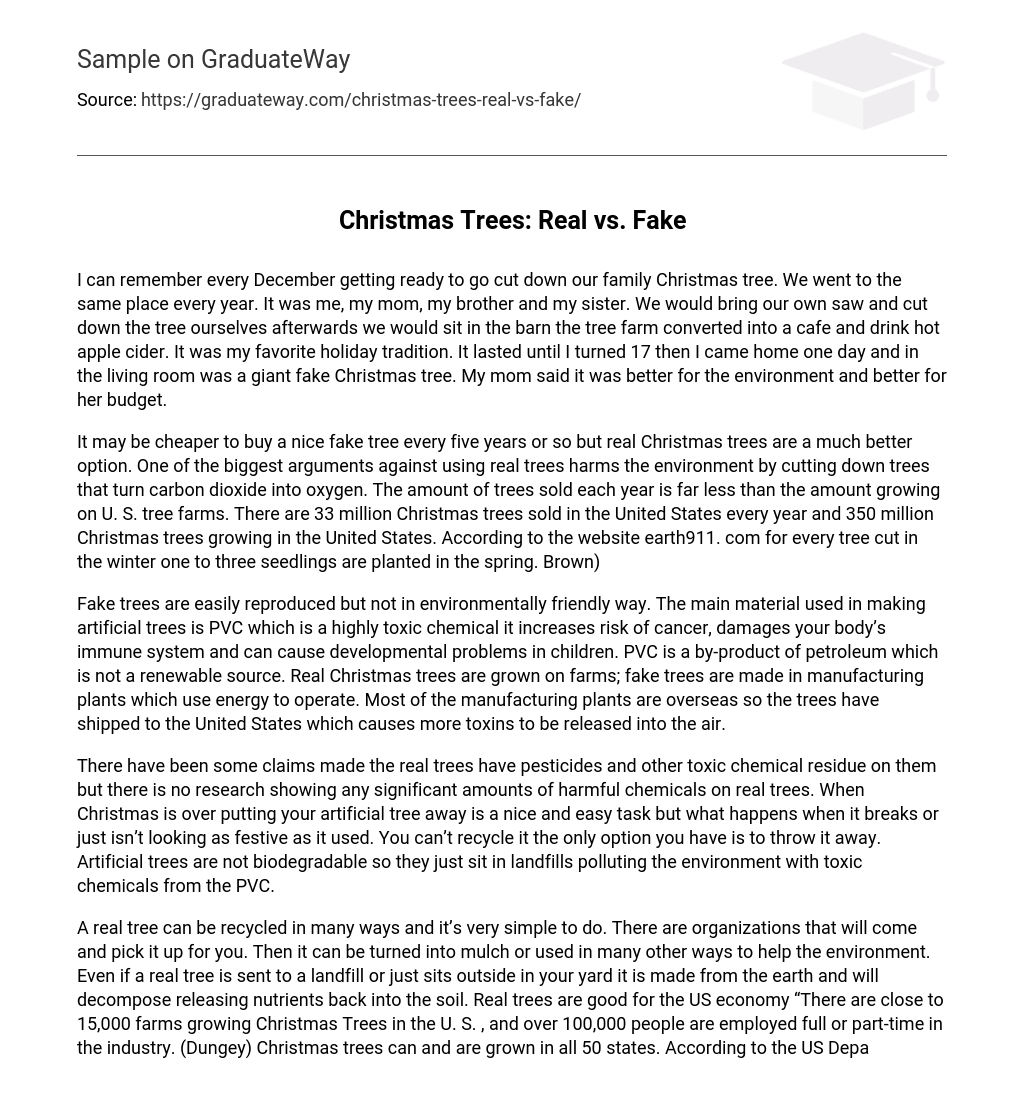I can remember every December getting ready to go cut down our family Christmas tree. We went to the same place every year. It was me, my mom, my brother and my sister. We would bring our own saw and cut down the tree ourselves afterwards we would sit in the barn the tree farm converted into a cafe and drink hot apple cider. It was my favorite holiday tradition. It lasted until I turned 17 then I came home one day and in the living room was a giant fake Christmas tree. My mom said it was better for the environment and better for her budget.
It may be cheaper to buy a nice fake tree every five years or so but real Christmas trees are a much better option. One of the biggest arguments against using real trees harms the environment by cutting down trees that turn carbon dioxide into oxygen. The amount of trees sold each year is far less than the amount growing on U. S. tree farms. There are 33 million Christmas trees sold in the United States every year and 350 million Christmas trees growing in the United States. According to the website earth911. com for every tree cut in the winter one to three seedlings are planted in the spring. Brown)
Fake trees are easily reproduced but not in environmentally friendly way. The main material used in making artificial trees is PVC which is a highly toxic chemical it increases risk of cancer, damages your body’s immune system and can cause developmental problems in children. PVC is a by-product of petroleum which is not a renewable source. Real Christmas trees are grown on farms; fake trees are made in manufacturing plants which use energy to operate. Most of the manufacturing plants are overseas so the trees have shipped to the United States which causes more toxins to be released into the air.
There have been some claims made the real trees have pesticides and other toxic chemical residue on them but there is no research showing any significant amounts of harmful chemicals on real trees. When Christmas is over putting your artificial tree away is a nice and easy task but what happens when it breaks or just isn’t looking as festive as it used. You can’t recycle it the only option you have is to throw it away. Artificial trees are not biodegradable so they just sit in landfills polluting the environment with toxic chemicals from the PVC.
A real tree can be recycled in many ways and it’s very simple to do. There are organizations that will come and pick it up for you. Then it can be turned into mulch or used in many other ways to help the environment. Even if a real tree is sent to a landfill or just sits outside in your yard it is made from the earth and will decompose releasing nutrients back into the soil. Real trees are good for the US economy “There are close to 15,000 farms growing Christmas Trees in the U. S. , and over 100,000 people are employed full or part-time in the industry. (Dungey) Christmas trees can and are grown in all 50 states. According to the US Department of Commerce over 80% of fake trees are made in China. A common misconception is that artificial trees are fireproof. They are flame retardant but can only withstand flames for a certain period of time. When it catches fire an artificial tree burns quickly and releases toxic smoke. If your real tree is watered well and proper precautions are taken such as turning the lights off when you’re out of the home or sleeping your tree won’t catch on fire and if it does it will do less damage than an artificial tree will.
There is nothing like a real Christmas tree. Picking one out every year is a great tradition for many families. The smell that comes with them is better than any candle or spray that is out there. Owning an artificial tree will save you time and money. Buying a real tree every year will save the planet for future generations to celebrate Christmas.
Bibliography
Brown, Lori. “earth911. com. ” 29 November 2010. 15 February 2011 . Dungey, Rick. 2005. National Christmas Tree Association. 15 February 2011 .





